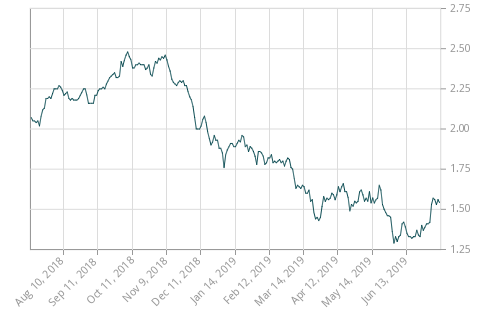The following is a list of all TSX-traded companies in the energy production sector that have a market capitalization of greater than CAD$1 billion. There are only 20 left. There are only 29 remaining between CAD$100 million and $1 billion. Some of them are not even domestic producers. Included are my VERY pithy notes.
Keep in mind that “profitable” here is a general and not strict description. Accounting (IFRS/GAAP) profitability may vary wildly with the colloquial notion of ‘profitability’, which is “can this company get more cash than it has to dump into its own production?”.
Out of the 20 companies:
* 6 are majority foreign operations (in descending market cap rank order: ECA, VET, PXT, EFR, CNU, FEC)
* 2 are royalty operations (PSK, FRU); similar to gold royalty companies, inherently there is nothing wrong with this, other than that these companies don’t have to directly incur much of the burden facing the rest of the industry at present
* 5 have some foreign operations, including SU (small), CNQ (small), HSE (small), CPG (~25%) and BTE (~40%).
Effectively, this leaves 12 majority-Canadian producers to invest in.
As a side note for Canadian nationalism, the “purest” operating Canadian oil major (no substantive operations outside of Canada) is Imperial Oil, but it is 69.6% owned by Exxon. Husky is majority controlled by Hong Kong finance titan Li Ka-shing. This leaves 10 firms left to invest in if you wish to exclude IMO and HSE because of their majority foreign-held ownership.
TSX Oil/Gas producers over $1 billion market cap
| Name | Ticker | MktCap ($Mil) | Notes |
|---|---|---|---|
| Suncor Energy Inc. | SU | 64,001 | Profitable |
| Canadian Natural Resources Limited | CNQ | 42,081 | Profitable |
| Imperial Oil Limited | IMO | 27,763 | Profitable |
| Cenovus Energy Inc. | CVE | 14,192 | Profitable |
| Husky Energy Inc. | HSE | 13,099 | Profitable; FCF mildly positive |
| Encana Corporation | ECA | 9,714 | Profitable; Majority USA |
| Tourmaline Oil Corp. | TOU | 4,538 | Profitable; FCF mildly positive |
| Vermilion Energy Inc. | VET | 4,407 | Profitable; mainly Europe operator |
| PrairieSky Royalty Ltd. | PSK | 4,299 | Royalty Company |
| Parex Resources Inc. | PXT | 3,072 | Profitable; Colombia operator |
| Crescent Point Energy Corp. | CPG | 2,370 | Profitable; FCF mildly positive; 1/4 US ops |
| Enerplus Corporation | ERF | 2,306 | Mostly USA; FCF neutral |
| CNOOC Limited | CNU | 2,299 | China |
| Seven Generations Energy Ltd. | VII | 2,269 | FCF mildly negative |
| ARC Resources Ltd. | ARX | 2,268 | FCF negative (neutral w/o dividend) |
| Whitecap Resources Inc. | WCP | 1,754 | FCF positive |
| MEG Energy Corp. | MEG | 1,490 | FCF positive; fairly high debt |
| Frontera Energy Corporation | FEC | 1,331 | LatAm producer |
| Baytex Energy Corp. | BTE | 1,130 | 40% Texas; FCF positive |
| Freehold Royalties Ltd. | FRU | 1,003 | Royalty Company |
Other notes
Just by eyeballing the valuations, a very passive investor could do far worse than just sticking their money in an equal-weighted fund of the top-five or top-ten and just sitting on it. Again, my “paper napkin valuation” is just that – a paper napkin take which ignores the quality (or lack thereof) of assets, or hedging portfolios, etc., but a 100,000 foot-above-the-sky valuation metric is instructive:
Looking at Suncor, they have operating earnings, plus depreciation, minus CapEx, minus CASH taxes and interest of $3.9 billion for the half-year. That’s about $2.50/share. It’s not as if they’re over-leveraged either – debt is about $15 billion. Considering they’re trading at CAD$38/share, they look cheap on immediate glance (multiple 7.6x). Management clearly thinks so as well considering they’ve been buying back shares like crazy.
CNQ’s 1H number is $2.9 billion, or $2.45/share. They’re slightly more leveraged ($24 billion in debt) but probably because they scooped up Devon Energy’s assets adjacent next to theirs in Alberta. Stock trades at CAD$32/share and the multiple is 6.5x.
The other top five, relatively speaking, look pretty cheap. CVE generated about $1.1 billion in free cash for the first half of the year (93 cents a share) which in relation to its $11.28 stock price, is a 6.1x multiple – they slashed their dividend earlier and have been using the money to pay down debt, which sits at around $7.1 billion and management has not made it a secret that they want it to get to around $5 billion. This should happen sometime in 2020.
What’s the danger in a broad-based index investment in these names? Commodity prices going down, and a continued hostile government environment for continued production. There’s going to be a lot of money on the sidelines awaiting the result of the upcoming federal election.
